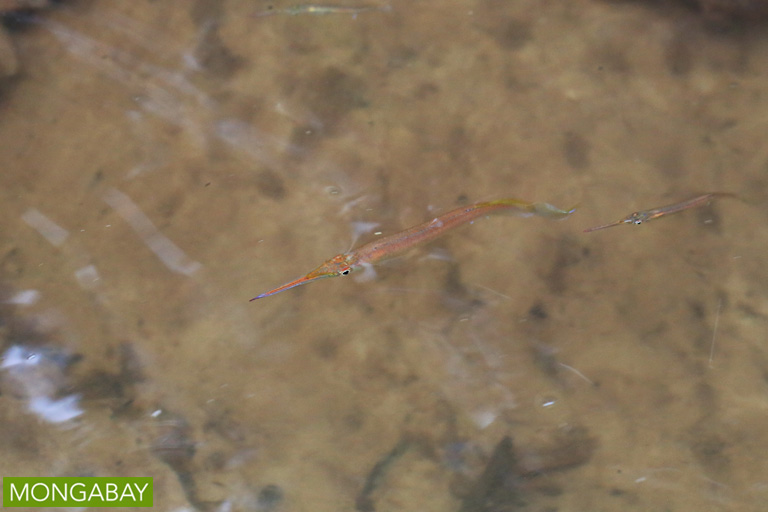- Within a palm oil dominated landscape, streams with riparian reserves on either side had more freshwater fish species than streams that lacked such reserves, researchers found.
- So retaining forest patches – even narrow ones – along streams in palm oil plantations can be effective in conserving aquatic biodiversity, a new study has found.
- In Indonesia and Malaysia, laws mandate retention of riparian reserves within the plantations, but such laws are often ambiguous and need to be enforced more strictly, researchers say.

Palm oil plantations often wreak havoc on biodiversity. But researchers may now have hit upon a win-win solution that allows freshwater fish to thrive in streams within palm oil plantations.
Retaining forest patches — even narrow ones — along streams (also called riparian reserves) in palm oil plantations can be effective in conserving aquatic biodiversity, a recent study published in Conservation Biology has found.
“To the best to my knowledge, this is the first study that investigated the impact of oil palm cultivation on freshwater fish communities, and the ability of riparian reserves to mitigate this impact,” Xingli Giam, lead author of the study who is now at the University of Washington, told Mongabay.
Within a 14,445-hectare palm-oil dominated landscape in Central Kalimantan in Indonesia, Giam and his colleagues assessed freshwater fish biodiversity in two kinds of streams: those that had riparian reserves along them, and those that did not.
These riparian reserves included “selectively logged and secondary forests that have been retained along tributaries,” the authors write.

The team found that streams that lacked riparian reserves had 36 percent fewer freshwater fish species than streams that had the reserves along them.
So “there exists a clear strategy — retaining riparian reserves — that is effective in conserving fish communities,” Giam said. “By retaining riparian reserves, we can retain levels of species richness and functional diversity that are close to a pre-conversion forest.”
The success of the riparian reserves is most likely due to presence of leaf litter at levels similar to those in forested landscapes, the researchers found.
Such leaf litter possibly supports fish communities by “enhancing and spatially concentrating their food resources — invertebrates, biofilm, and algae,” they write. “Leaf litter also provides fishes with a cool, dark microhabitat and shelters them from predators.”

In many cases, much of the land next to streams would have already been deforested, Giam said, and there might be just a thin strip of logged or community-altered riparian forest remaining. “In this case, growers may be tempted to just clear off this small strip of forest, but we show that even small strips of riparian forests can benefit fishes.”
However, Giam warns that palm oil growers should not use this finding to justify trimming riparian forest reserves. “No study has yet determined the optimal riparian reserve width for conserving fish or preserving water quality in tropical oil palm plantations,” he said.
In two of the world’s biggest palm oil producers — Indonesia and Malaysia — law mandates retention of riparian reserves within the plantations. However, such laws are often ambiguous and not strictly enforced, Giam said.
“In 2011, the Indonesian government has announced the Indonesian Sustainable Palm Oil (ISPO) system, which aims to audit whether all growers (private, large-scale growers to smallholders) comply with Indonesian law,” he added. “It remains to be seen how effective the ISPO system is in ensuring that growers retain riparian reserves.”

Citation:
- Giam, X., Hadiaty, R. K., Tan, H. H., Parenti, L. R., Wowor, D., Sauri, S., Chong, K. Y., Yeo, D. C. J. and Wilcove, D. S. (2015), Mitigating the impact of oil-palm monoculture on freshwater fishes in Southeast Asia. Conservation Biology, 29: 1357–1367. doi: 10.1111/cobi.12483